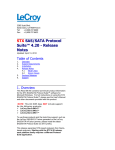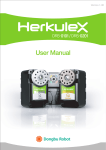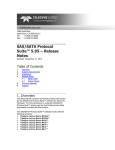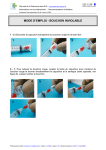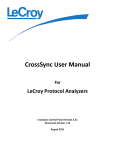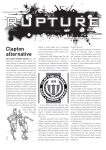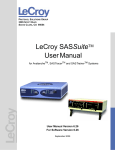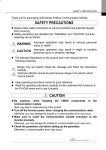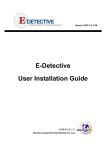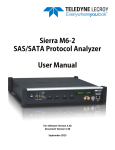Download SAS/SATA Protocol Suite™ Release Notes
Transcript
3385 Scott Blvd. Santa Clara, CA 95054-3115 Tel: +1/408.727.6600 Fax: +1/408.727.6622 SAS/SATA Protocol Suite™ 3.30 - Release Notes Updated: February 20, 2009 Table of Contents 1. 2. 3. 4. 5. 6. Overview System Requirements Installation Release Notes 4.1What’s New 4.2Known Issues Previous Releases Support 1. Overview This Read Me file contains last-minute product information for the SAS/SATA Protocol Suite™ software for Microsoft Windows. For full instructions on using the SAS/SATA Protocol Suite™ please see the User's Manual and other documents provided with this product. 2. System Requirements 2.1. The following is a list of recommendations for the configuration of the host machine that runs the SAS/SATA Protocol Suite™ application and that is connected to the Sierra M6-4 system or STX systems. Please note that the application would operate on systems with less memory and slower CPU rate than the recommended; however, for best results it is recommended that the host machine meets or exceeds the suggested configuration. Software Operating System: Microsoft Windows 2000 or Windows XP Required setup: Microsoft Internet Explorer, version 6 or newer 2.2. Hardware Processor: For optimum performance, use processors of Intel's Pentium4 family, AMD’s Athlon/Duron family, or newer compatible processors. Memory: Minimum is 1GB of RAM. Hard Disk: 100 MB of free hard disk space is required for installation. Additional disk space is needed for operation of applications and for storing recorded data in files. Hard disks with fast access times are recommended. Display: Resolution of at least 1024 x 768 with 16-bit color depth is recommended (resolution of 800 × 600 with 16-bit color is a minimum). Connectivity: Due to the high-speed uploads, a USB 2.0 interface is recommended for the connection with the SAS/SATA Sierra M6-4 or STX analyzer (USB 1.1 is a minimum). This is not a requirement if the analyzer application is used only to view pre-recorded traces. If multiple Sierra M6-4 or STX analyzers are cascaded together, one USB port (or one Ethernet connection) per analyzer is needed. Cascaded traces are proportionally larger than traces captured with a single analyzer. The time required to upload and display these larger traces can be reduced by: - Increasing system memory, and - Using a system with a faster processor 3. Installation Please refer the “Installing your Analyzer” chapter of the User's Manual for the details of SAS/SATA Protocol Suite™ software installation. 3.1. CD-ROM Installation Insert the CD ROM with the Analyzer software in the CD ROM drive. The installation will automatically start unless the Auto Run is turned off. In this case select the CD ROM from “My Computer” and double-click Autorun.exe From the CD ROM Autorun program, choose the Install Software menu item and then choose SAS or SATA Software. Follow the on-screen instructions to complete the installation 3.2. Web Package Installation • 3.3. • • Run the setup and follow on-screen instructions to complete the installation. USB Driver Installation USB driver files are automatically installed with the SAS/SATA Protocol Suite™ software installation. Windows 2000/XP users must have administrator privileges to install the required device drivers. Do not connect the analyzer to the USB port until the software installation is complete. In case it is required to manually reinstall the device drivers, they are located in the SAS/SATA Protocol Suite™ program folder. For example: C:\Program Files\LeCroy\ SAS Protocol Suite\Driver\USB 4. Release Notes 4.1. What’s New • • • • • 4.2. • • • • This is version 3.30 of the SAS and SATA Protocol Suite. This release contains the following components, which are necessary for the operation of the product: • SAS Protocol Suite Version 3.30. • SATA Protocol Suite Version 3.30. This release includes the following updates: Added Features: • CATC SASTrainer functionality, which was offered on the UPAS10k platform, is now supported on the Sierra platform, as Sierra Trainer Traffic Generator, and supports 1.5G, 3.0G & 6.0G data rates. SASTrainer scripts are compatible with Sierra Trainer. • CATC Trace View feature allows viewing captured traces in both legacy Catalyst format and legacy CATC format • Memory Segmentation feature (Sierra M6-4 only) allows rearming the trigger multiple consecutive times and capturing segments of data around each trigger. Each segment can then be uploaded separately. • Supporting SATA compliance IO on Sierra M6-4. • Remote update (allows automatic checking for new versions of the software). • 16 GB recording memory support for Sierra M6-4. • Support for new STX A6-4 platform. Issues Fixed are: • Default gateway is supported for Sierra M6-4 Hardware. • USB is now supported for all functionality except Infusion. • External signals on STX-131 are now enabled. • Some crashes were fixed. • Some cases where the software lost connection to the box were fixed. • Various bug fixes. Known Issues USB2.0 is not supported for Infusion, and will be enabled in the next release. In certain cases, when multiple network adapters exist in the host PC, Windows selects to use the wrong adapter to connect to the Sierra system. This prevents connection. The work around is to disable all other network adapters, connect to the box over the desired network adapter, and then reenable the other network adapters. The Target Emulator may lose link if a trace is made at a set speed and then another trace is made at auto-speed. To avoid this the Analyzer and Target Emulator should both be set to autospeed or fixed speed. Since Auto-Speed Negotiation is not provided for SATA at 6Gig, the capture speed must be set manually by setting the proper speed in the settings menu, then starting and stopping a capture. Future linkups will be correct. • • • • • • • • • • • • • • (Analyzer Muxing) The Analyzer needs to detect MUX primitives from both host and device sides in order to capture the traffic correctly in the muxing mode. (Auto Speed detection – only STX231 and STX431) It is recommended to set the analyzer speed to 1.5G when you want to capture the speed negotiation of SATA 1.5G. In this case if you use auto speed detection about 30us of beginning of speed negotiation is lost. (Advanced Analyzer) Events on each link are counted independently. This means a condition is met if the number of events on a link equals the defined occurrence. (Analyzer Cascading) Because of using a chain connection for cascading boards and delay of signals, the traffic on different boards is not completely time synchronized. There is about 1 DWORD difference between each two consecutive boxes. (Capture and Trig patterns) STX230 with VP50 FPGA only supports one data pattern rather than two data pattern of other products. The STX460 SATA host emulator cannot establish a link in lower speeds with the devices that support all speeds. For example if a drive supports both 1.5G and 3G, the emulator doesn’t work in 1.5G. This issue is due to the MGT long lock time. Meanwhile this issue causes the SATA compliance test GTR-02 to fail for the devices that support all speeds. On the STX460 & Sierra emulators, delay of sending HOLDA in response to HOLD is not compliant to spec. According to the spec this delay should be less than or equal 20 DWORDs for 1.5Gbps and 3Gbps. The spec for 6Gbps is not released yet. This delay on STX460 is 19 for 1.5Gbps, 23 for 3Gbps and 27 for 6Gbps. Reason of this issue is the MGTs long delay on the Virtex-4. As we checked with many real HBA and drives, looks like they have no problem with these values. In advanced analyzer the Set to LOW of External Trigger Out doesn't work correctly. (Device/Target emulator) does not correctly work in 1.5Gbps on VP50 boards. In device emulator if NCQ is enabled, symbol violation and running disparity errors would be observed. In a target emulator there is a problem if it is suddenly disconnected when bulk data is transferred. When too many state jumps happen in Advanced Analyzer in a short time, one of the hardware queues overflow. This causes some frames to be corrupted. This case happens when an infinite loop is created in Advanced Analyzer and state jumps occur very quickly. This issue is observed for 3G on STX430/STX431 and for 6G on STX460. On STX43x if you have many jumps and interval between jumps is less than 40 DWORD (40*13.3333ns) for a long time you will observe the issue. For example if interval between jumps is 30 DWORD, you will see the issue after about 70 jumps. For STX460 you will see the issue if interval between jumps is less than 60 DWORDs for a long time. Sometimes the SATA emulators do not wake up correctly by COMWAKE and need a PHY reset to wake up. As tested this issue happens rarely. In SAS initiator if a handshake to a received frame is deferred via error injection, a wrong task command is issued. (External Trigger Out – only Sierra) The external trigger out can be only be programmed once per each run. At 6G speed, state transitions can only happen every other Dword in the Jammer. 5. Previous Releases 5.1. Version 3.21 • Issue with cascading Jammers is resolved. 5.2. Version 3.20 • • This is version 3.20 of the SAS and SATA Protocol Suite. This release contains the following components, which are necessary for the operation of the product: • • • • SAS Protocol Suite Version 3.20. • SATA Protocol Suite Version 3.20. This release includes the following updates: Added Features: • Jammer functionality is extended to support 4 ports at 1.5G, 3.0G & 6.0G data rates. • Up to 2 ports of Jammer can run simulatenously with up to 2 ports Analyzer(s) and / or Emulator(s). This is offered in each of SAS & SATA software. Issues Fixed are: • Issue with Jammer A/J/A case on Port 3 & 4 in SATA is resloved. • Logging is supported in the Jammer. 5.3. Version 3.10 • • • • 5.4. This release contains the following components, which are necessary for the operation of the product: • SAS Protocol Suite Version 3.10. • SATA Protocol Suite Version 3.10. This release includes the following updates: Added Features: • Jammer functionality that was offered in Infusin product is now provided in Sierra Jammer and supports 1.5G, 3.0G & 6.0G data rates. • Jammer function (Infusion) can run one port while Analyzer(s) and / or Emulator(s) can run on other ports, simultaneously. This is offered in each of SAS & SATA software. Issues Fixed are: • Error injection of CRC over mixed SAS & SATA taffic is fixed in Jammer. • Train & Train Done primitives are supported in Jammer. Version 3.00 • • This release contains the following components, which are necessary for the operation of the product: • SAS Protocol Suite Version 3.00. • SATA Protocol Suite Version 3.00. Added Features: • Four Channel Emulation for Initiator, Target, Host and Device supporting up to 6Gig data rates in Sierra M6-4 • Support for Gigabit Ethernet in Sierra M6-4 • Auto-speed negotiation for SATA 3.0/1.5Gig 5.5. Version 2.80 • • • • • • • • Compression of successive primitives has been added. Software is now able to compress primitives with IDLE data in between. Support for triggering and decoding of SAM-4, SPC-4, MMC6, ADC3, OSD-2, SMC-3 and SBC-3 commands. Ability to send SAM-4, SPC-4, MMC6, ADC3, OSD-2, SMC-3 and SBC-3 commands are now supported in Initiator Emulator. Support for triggering and decoding of NV CACHE commands. Support for NV Cache commands has been added to Host Emulator. SAS SW now fully decodes and displays SNW traffic in both the Waveform and Packet views. SNW-3 capabilities bits are now decoded. TRAIN and TRAIN_DONE primitives also added to Waveform view. Performance of Host/Initiator Emulator is increased to address SSD market. Minor Features Added: • Ability to choose commands based on Hex value added to Host/Initiator Emulator. • Multilevel Filtering now has ability to choose pair address for easier use. • Ability to send a file instead of specifying pattern for BIST command with Host Emulator • Decoding of obsolete ATA commands. • Complete decode of SATA IDENTIFY/IDENTIFY PACKET response data. • Option to loop errors in Target Emulator. • Option to randomize errors in Host Emulator. 5.6. Version 2.72 • • • • • • • • • STX primitive trigger in cascaded mode issue is fixed. 2 GB memory module support has been added to STX460, resulting in 8GB analyzer system memory support. Probe setting issue on STX 460 has been fixed SATA compliance tests have been updated based on MOI version 0.99c. Issue with IPM -11 has been fixed for SATA compliance. Name of fields in Register Host To device frame have been changed based on SATA spec 2.6. Issue with (SATA) viewer stops showing COMWAKE when capturing Power Mgmt is fixed. LBAs are shown in spreadsheet view for all LBA access ATA commands. Auto Detect is provided in STX460 when the unit is licensed for 3G SAS recoding. 5.7. Version 2.70 • • • • Display of scrambled Idle pattern has been added. There is an option in capture project setting page named "Show XXXX value", when this option is selected, the value of XXXX data is shown in the viewer for SAS & SATA application software. You can set viewer display mode to “Like CATC viewer”. There is an option in software settings named “Look like CATC view” selected by opening software settings dialog form configuration menu. When this option is checked, the packet view will look like CATC packet view. "Set as Default" has been added to SAS address alias name dialog. When you set alias name for specific SAS address and press "Set as default" button, it will be applied on current trace and all traces that will be captured. All features of spreadsheet view have been implemented in text view. There are a lot of “Go to” operations in right click pop up menu of text view that are implemented in this release. • • • • • • • • • • • • • • • New SAS 2 SMP commands have been implemented. You can send new SAS 2 SMP commands by initiator emulator and you can see complete interpretation of them in viewer too. “AND” operation has been added to filter dialog. Multi level filtering has been added to filter dialog. You can do multi level filtering as post process on the viewer. Please note that when you use multi level filtering, the given filter options will be applied on the results of previous filtering process. Kill button has been added during uploading and extraction process. When you check “The cancel button kills uploading/extracting sample file” in software settings dialog, then when you press “Cancel” button during uploading trace file, it is applied immediately after pressing it. All SATA compliance tests have been updated according to UTD version 1.2. Emulator multiplexing feature has been added on STX460 with below stipulations: Both host emulator and device emulator support Muxing. STX460 can have 2 narrow ports emulator with no muxing -OR- a 1 port emulator with muxing When you use muxing in emulator (host or device), there is no analyzer support on ports 1 and 2. Multi port emulator support has been added on the STX460. Both host emulator and device emulator support multi port. When you use Multiport in emulator (host or device) on STX460, there is no analyzer on ports 1 and 2 Each SXT460 is limited to 2 emulators running simultaneously. Emulators ports both have to be either “Host Initiator” OR “Target” only. The Memory of each Emulator port is increased to 511 MB. It means you can write exerciser script up to 511 MB. Please note when you use single port Initiator emulator/Analyzer project, the sampling memory size is limited to one memory module on STX460 board and the emulator memory will still be 511 MB. 5.8. Version 2.64 • • • • • • • • • • • • • • Support for STPHY3 Rev C Fixed application crash in target emulator during error injection by command number. Multiplexing has been added to SAS software. Auto speed detection has been added to SAS for analyzer and emulators on STX460. SATA compliance test support has been added to STX460. Two options have been added for the spread sheet view software settings as below: Repeat decoded command in frame column Decode CDB of command (if you don’t check it, we show the raw data of CDB instead of decoding it) In the spreadsheet view, we added a data icon (shown as D) on Read/Write commands for showing transferred data by command. In the SAS target emulator and SATA device emulator: Added the ability to specify an LBA range to error injection In the SATA device emulator: the Smart feature set has been added. You can enable Smart feature set in setting page, advanced, Miscellaneous Features tab of device emulator. In the connectivity window, a progress indicator has been added during scanning USB/Ethernet devices. Added "Any Open Reject” to the primitive list in trigger and capture menus. Now you can trigger or filter on “any open reject”. Host/initiator emulator: Size of data compare has been increased to 2048 DWORDs. • • • Host/initiator emulator: Maximum value of loop counter has been increased. "Set as factory” feature has been added to Host/Initiator advanced settings. Analyzer: Fixed an issue seen in the advanced analyzer during cascading 5.9. Version 2.5 • • • • Trusted command set command interpretation has been added. Some changes have been applied on compliance test to supporting ATAPI drives (SAS Initiator/Target Emulators): Scrambling option for 6G speednegotiation to pause the trainer scrambler while primitive is added. (SAS Initiator Emulator): Auto Increment the LBA by a userselectable number 5.10. Version 2.4 • STX Release 2.40 provides support for all of the following products: STX230, STX231, STX430, STX431 and STX460. • The ability to cascade STX460 with STX430/431 has been added. For cascading to work properly, you must put all STX460 boards first, and then you place any STX430/431 boards after them 5.11. Version 2.3 • Added supports for 6Gb/s host and device emulation (SAS and SATA versions). 6. Support 6.1 Online Download Please periodically check LeCroy Protocol Solutions Group’s web site for software updates and other support related to this product. Software updates are available to those users with current Maintenance Agreements. 6.2 Online Support Web: E-Mail: http://www.lecroy.com/ mailto:[email protected] 6.3 Phone Support Voice: Fax: +1 800 909 2282 (USA/Canada) +1 408 727 6600 (worldwide) +1 408 727 6622 (worldwide) 6.4 Sales Information E-Mail: mailto:[email protected] © Copyright LeCroy Corporation 2008 LeCroy, LeCroy Protocol Solutions Group, CATC, Catalyst, SAS/SATA Protocol Suite™, Sierra, STX, Sierra M64™, STX-460™, STX-431™, STX-430™, STX-231™, STX-230™, STX-131™ are trademarks of LeCroy Corporation. Microsoft Windows is a registered trademark of Microsoft Inc. Pentium is a trademark of Intel Corporation. Athlon and Duron are trademarks of Advanced Micro Devices, Inc. Acrobat, Acrobat Reader and the Acrobat logo are trademarks of Adobe Systems Incorporated. LeCroy reserves the right to revise these specifications without notice or penalty.












